We woke up in Deadwood, performed our morning constitutionals, and left the hotel looking for breakfast. It's odd eating breakfast every morning - normally I just have coffee and maybe cereal, but evidently Gus actually eats a real meal.
We walked towards downtown Deadwood, which was fairly busy for an early Monday morning.

I particularly liked the sign for Goldberg's Ice Cream Shoppe. Jewish ice cream store merchants in the Old West - there's a PhD dissertation right there.

On our way to food we saw Saloon #10, which is famous as the place in which Wild Bill Hickok was shot and killed. The original burned down a long time ago, so this isn't the same building, but it is the same spot.

As we walked in, I saw quite a warning on the door.
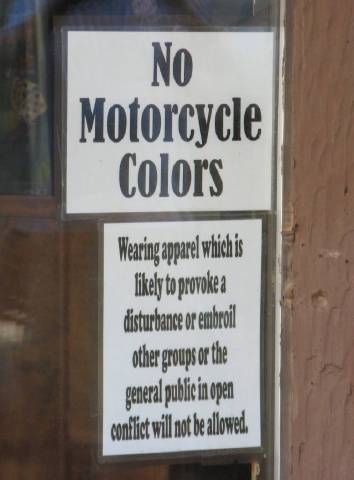
I made Gus take off his 'NYC Patriots Haters' leather jacket and his blue Crips bandanna, and we walked in.
It's pretty old-timey even if it isn't the original. It smelled really good in there, and then Gus pointed out why: the floors were covered in sawdust!

That was actually really cool. I wish more bars did that. It smells good, I'm sure it cuts down on smoke smells, and it looks really neat.
We walked around until we found the spot where Wild Bill would have been shot.
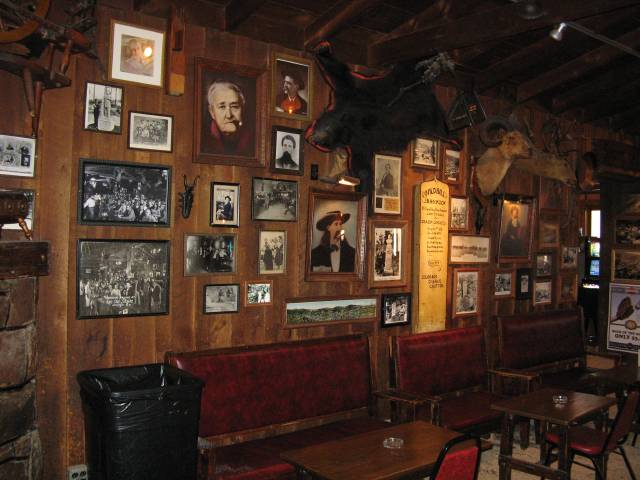
It's right by the fireplace, which makes sense. Now the wall is covered in pictures of Wild Bill and other famous Deadwood citizens, as well as other Wild Bill memorabilia.
Unfortunately, they didn't serve breakfast. We asked where to go, and the barmaid suggested the Iron Horse, a few blocks away.

It's also a hotel and a small casino as well as a restaurant. In fact, since the frickin' slot machines were about 4 feet away from us, there was smoke everywhere. Blecch.
We sat down and ordered. Once again, the waitress evidently misheard my order as 'Butter with a side of toast and eggs ... oh, and can you put extra butter on it? Hey, don't forget the butter!' Other than the fact that everything was slathered to the point of saturation in butter, it was good.
We left the smoke and the butter and walked down the street in the direction of what I think is the Court House.

As least it sure looks like a court house. Our real goal was right before the Court House: the Adams Museum of Deadwood.
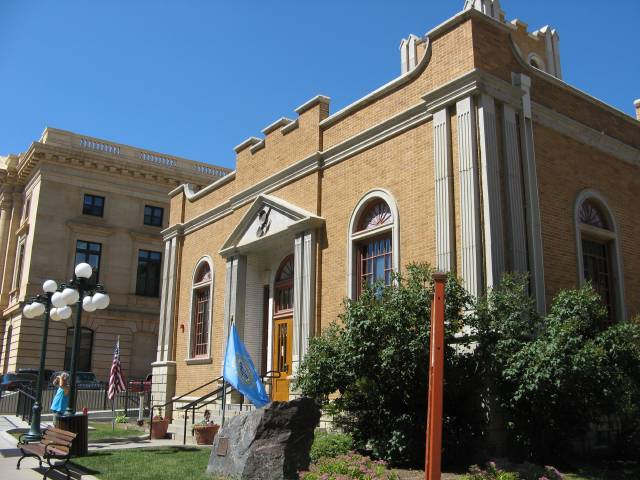
This was really pretty good. They had lots of interesting historical artifacts from Deadwood's past, with one exhibit about prostitution that was particularly eye-catching. Evidently prostitution wasn't made illegal here until 1980! The last brothel in town, Pam's Purple Palace, had to close and everything was auctioned off. Too bad for Pam.
I have no pictures because they wouldn't allow pictures. Boo.
We spent about 45 minutes in the Museum and then left to check out by 11 am. On our way back I saw this ad on the side of a building.

I love those sorts of ads. You just don't see 'em any more.
We checked out of the Deadwood Hampton Inn, and it was time to drive from South Dakota to Montana, via a short jaunt through Wyoming. After driving a couple of hours, we were in Wyoming, and we had to stop for lunch. Gillette, WY was as good a place as any. Gus ran in to the Arby's while I made a fake meat wrap. As we were leaving, I saw this outside a C-store.

Nice spelling, Loaf 'n Jug (and what kind of name is that, anyway?).
On we drove, finally crossing over into Montana. At once I began singing the theme song fromThe Magnificent Seven, which Gus joined. Dun dun-duh-dun dun-dun duh-dun-duh-dun doo-deeee doo-dee-doo-deeee ... I have no idea why we did that, since the movie isn't set in Montana, but it seemed appropriate. And it was fun.
As you've probably noticed, I've taken many pix of Gus while he's driving, as he's quite the photographic subject. What you may not know is that Gus is quite the techno-adopter as well. You can tell, 'cause he uses a bluetooth headset (not me ... I don't want brain cancer).

We drove on, and the landscape changed a bit too. There were some desolate looking farms.

And some gently meandering rivers.

The land was flat, but you could see mountains rising up in the distance.
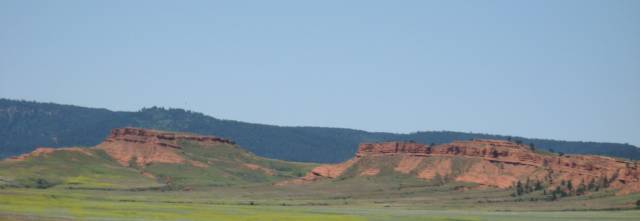
The sky was huge, clear blue with fluffy clouds as far as you could see. The corn was as high as an elephant's eye, and ... wait. Wrong state. Anyway ...
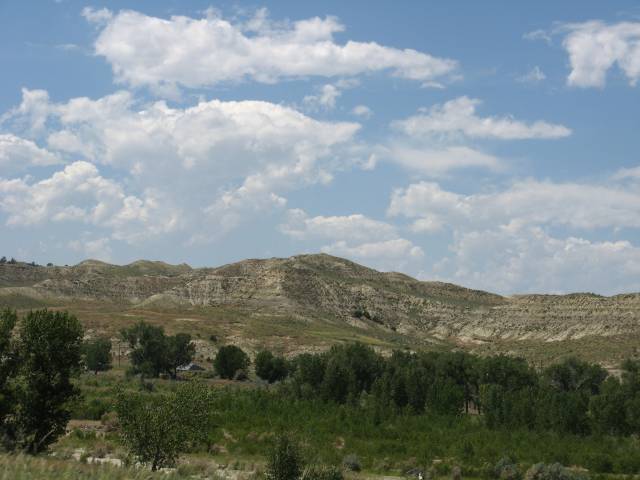
Here's a movie I took when we stopped by the side of the road. It's not the greatest, but it'll give you an idea of what Montana looks like (or at least the highway in Montana).
Rocky outcroppings were common, with very little vegetation on them.

At one point I stuck my head out of the window to take a shot as we drove along at 80 MPH. I brought my head back in, and had quite the 'do.

Here's a few more photos of the landscape through which we drove.


It was very beautiful, but the whole time I was thinking, 'Lovely to visit; wouldn't want to live here.' I'm a city boy.
This is one of my favorite pictures so far. It's just a lonely telephone pole on a hill, but it captures that feeling of how little people matter against the vastness of this landscape.

I also colored it in sepia. Don't know if it's better or not, but I like it too.

We got closer and closer to Little Big Horn, the site of Custer's Last Stand and our next big stop. And then some morons on motorcycles blew past us (not all motorcycle riders are morons, but these folks definitely were). Keep in mind, we were going about 80 MPH, and these idiots passed us easily, which means they were going about 90. Notice they have (a) no helmets, (b) no protective gear, & (c) winds blowing their carrier around. What dumbasses!
Yeah yeah yeah ... your freedoms and your rights and all that crap. The point is, you're endangering yourselves and others, and when you crash and end up in the hospital (although you'll probably just die), it's going to take resources away from others who weren't so reckless and foolish. I'll say it again: morons!
We stopped just outside Little Big Horn at a gas station. While there, I took a picture of a more sensible rider and his lady companion.
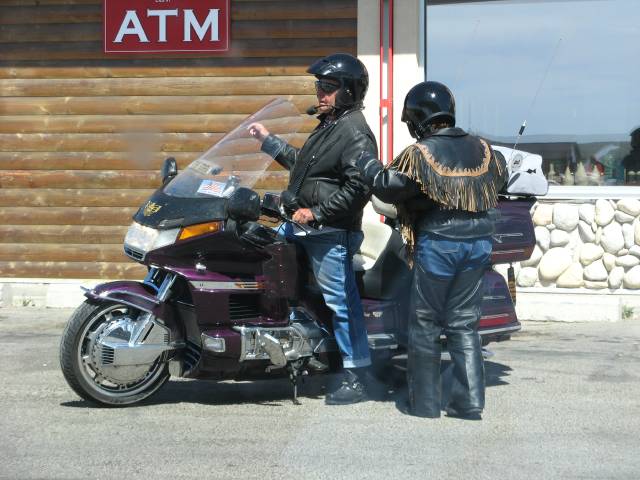
Yep, they're older. And wiser. It was amazing to me how many motorcyclists there were on the roads as we traveled, and how old many of the riders were. In fact, they seemed to be riding with other couples, communicating via microphones in their helmets. 'I wonder why there are so many motorcyclists!' I said to Gus.
'It's simple,' Gus replied, 'These are nice, flat roads, so you can see what's coming. It's safer, and this is beautiful country to ride through on top of it. Makes perfect sense.'
Yep. He's right.
We reached Little Big Horn, which is in the middle of a Crow Indian Reservation. The battlefield is actually about 5 miles wide, but maybe 2 miles deep. We arrived at about 3:45 pm, and finally drove out close to 9 pm, so we spent over 5 hours there. In short, we did it all, and explored pretty much everything we could. We had no idea we'd both enjoy it this much, but we did, and I recommend it highly to anyone who wants to learn more about American history.
The parking lot is right next to Custer National Cemetery (Custer himself is buried at West Point), which is a cemetery for soldiers from any war and their families. Those who died with Custer are not buried there, as you'll soon find out. The Cemetery isn't taking anyone any longer, unless they already had a plot reserved. It's very beautiful in that way that many soldier's cemeteries are, like Arlington - all those small white tombstones, lined up one after the other.



You have to say, they're buried in a beautiful setting, under the sky and with a broad expanse beyond the hill.

There were some tombstones that stood out. Some for historical reasons, like this one of Custer's 2nd-in-command, Marcus Reno. Custer told Reno to attack while he moved around to a different side of the Indian camp. Reno was badly outnumbered, so he had to retreat, and he ended up holding out for another 36 hours before he was rescued. Meanwhile, Custer walked right into his doom. Reno was blamed unjustly for the massacre, and died disgraced, but at least he's buried here. I wonder if he requested that.

Many Indians who acted as scouts for the US military are buried in this spot as well, which seems fitting. Here's White Man Runs Him.

And Curly, who was at Little Big Horn, but not with Custer, hence his survival until 1923!
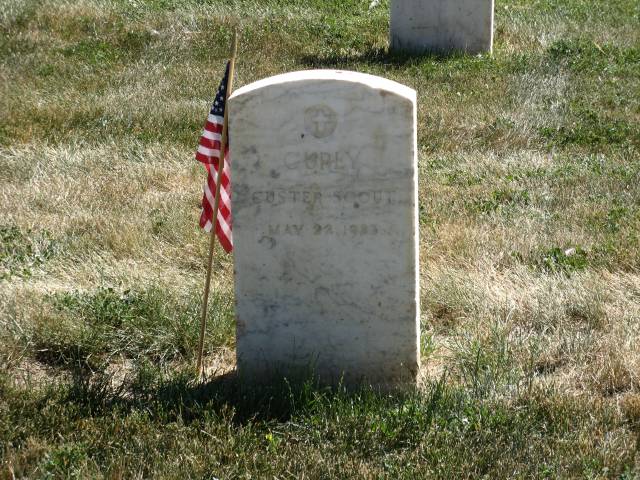
Gus and I also saw a tombstone that made us laugh. That's quite a name: Evan Evans!

Wives of soldiers have also been buried there as well. This was one of the most ornate tombstones we saw.
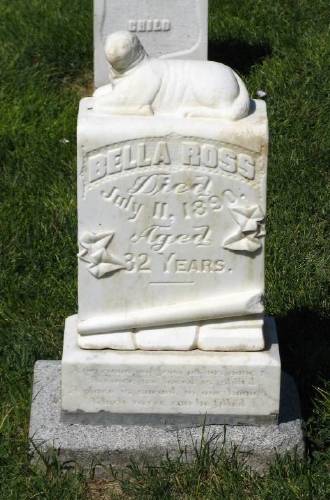
As we walked out, I noticed a sign there with what appeared to be a poem about these dead soldiers. I don't know if it's common in other military cemeteries, but I thought it was very touching.

It was a beautiful cemetery, and I'm glad Gus and I saw it first.
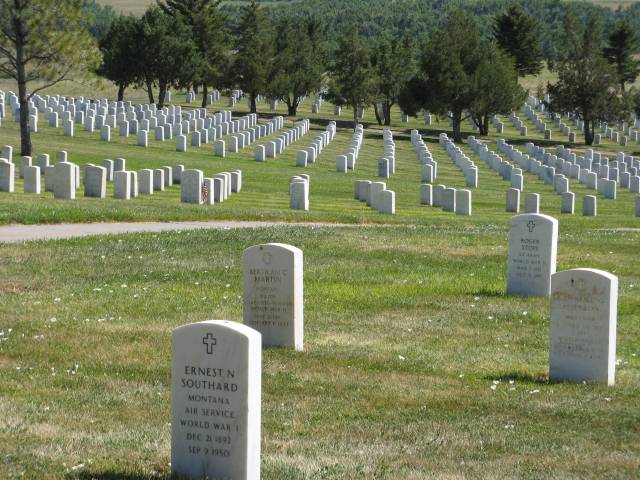

We went in to the Visitors Center and looked at the exhibits, and then went outside on the patio for a 4:30 talk by a ranger. Jerry was really great, and looked like a Hollywood Park Ranger: tall, thin, tan, handsome, with a great voice. He knew his history cold and spoke for about a half hour about the reasons for the battle, what happened, and what the outcomes were. It was really excellent, and it proved a great intro to our experience.
Time to walk up to Last Stand Hill, which is where Custer's body was found, along with about 40 or 50 others. It wasn't really the last place men died, however, as you'll see later. We walked up the nearby hill.

As you get closer, you can see how many men fell here. Each marker indicates a spot where a soldier's body was found. No other battlefield in the world can claim that level of detail. It really helps to bring home just what happened here, 131 years ago one week previously (the battle occurred on June 25, 1876, and we were there on July 2, 2007).

Finally you reach the top, and there are the markers of the men who fell directly with Custer (men died in many more areas, as you'll find out).

And there is Custer's marker, different from all others.

Behind us stood a monument listing everyone who died on the side of Custer, including Indian scouts and civilians attached to the Army. Under that monument is a mass grave with the bones of the soldiers who died on this battlefield.

This panoramic movie gives you a good idea what you can see standing up there. Note the terrain and think about what you'd do if you were surrounded by about 10 times the number of men you had.
Across the road is a much newer memorial for the Indians who fought against Custer. This is a nice touch, I think, and I'm glad it's there. Both sides thought they were fighting for a just cause, and in fact, Custer himself said that if he was an Indian, he would have been doing exactly what they were: fighting to preserve their home and their way of life.
As you walk across the road, you first see a marker for the horses and mules who died there. Custer ordered his men to shoot the horses as a way of providing cover for them to hide behind as they defended themselves. As you can see in other photographs, there isn't much to hide behind here.

We reached the Native American Memorial, which was really well done. It features a sculpture of wire.

The other parts of the circle are a wall with information about the various tribes and warriors who fought there. I took a panoramic movie that shows you what it's like.
At this point, we walked back into the Visitors Center. Gus bought a magnet, and then we saw a CD-ROM that you play in your car as you drive through the battlefield. It takes about 1.5 hours. Sounded good to us, so we bought it, unwrapped it, put it in the car's CD player, and started off.
Friends, it was excellent. This is agreatway to experience Little Big Horn. If you come here, you should definitely buy the CD and do the tour yourself. Gus and I thoroughly enjoyed it.
One of the things we saw early on is the site of the Indian encampment that Custer was trying to attack and capture. It's in the flat area on the other side of the river. Imagine several thousand tipis there, with around 6-8000 people, including 1500 or so warriors. Custer had a few hundred soldiers. Not good odds.
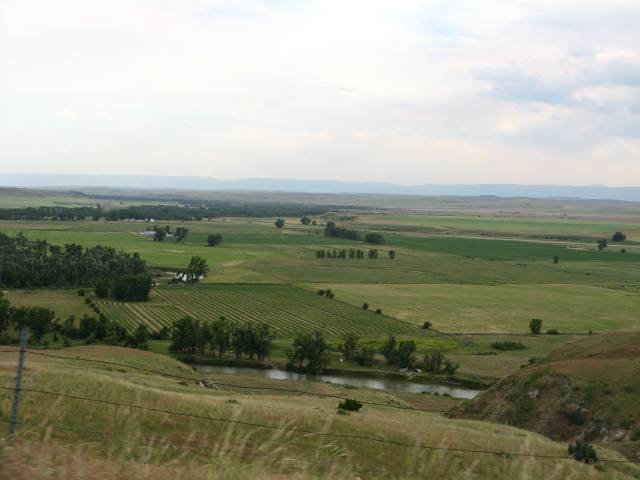
As we drove, we saw how hilly much of this area was. Fighting on this terrain would be terrible.

Looking up, the sky couldn't decide what to do. I like this shot a lot, with the fence and the clouds and the sun.

At the other end of the battlefield from Custer's hill is the Reno-Benteen battle area. Reno and Benteen were with Custer, but weren't among those who were slaughtered, as Custer split them off before the engagement started. However, they had quite a time of it, and were under siege for 36 hours by Indians before being relieved. We parked there and got out to take the walk along a path that shows the key points on this side of the Battle of Little Big Horn. It took about 1/2 hour, and it added a lot to our understanding of what happened.
On our walk, I couldn't help pointing out to Gus the huge size of the dandelions here. Some of them were 2 1/2 to 3 inches in diameter. Enormous!

At the end of the walk, you see the spot where 16 soldiers volunteered to run down this ravine to get water while they were still under siege by the Indians. They got commendations, as they should have, as that is real bravery. Imagine running down this steepness while being shot at, and then running back lugging as much water as you could carry. Boggles the mind.

There were tombstones commemorating the Indians that died as well. Those who fought for Custer are white, while those for the Indians are red. There are far fewer red stones, since fewer Indians died, and we have far less knowledge about where exactly they were killed on the battlefield.

Dark clouds rolled in, and we thought it presaged a storm, but none ever came.

Standing where we were, I thought about the horrible violence that had killed so many, in such a lovely spot.

We moved on, and Gus walked ahead of me,

and then he went over a hill. When I came up over the hill after him, I stopped as I saw the sky and took this picture. You can see Gus' head silhouetted against the horizon on the left. I love this shot, with the clouds and the sun breaking through and the vast distance.

As we approached the tail end of the tour in our car, we passed some horses grazing in the grass. There was a foal with them, but he was kind of shy and hid behind his mama's legs.

We drew closer to Last Stand Hill, where we had begun. Several hundred yards before you get there, though, and on the other side of the road, is a stop. We got out and read the exhibit there and looked. This is called the Keogh Sector, and essentially a group of soldiers tried to run northwest through this area after their position collapsed on a hill to the northeast. They were trying to reach what we now call Last Stand Hill, and the majority didn't make it (although those that did weren't any better off!). See those little white dots? Each one of those is a grave marker where a man fell, killed by the Indians.
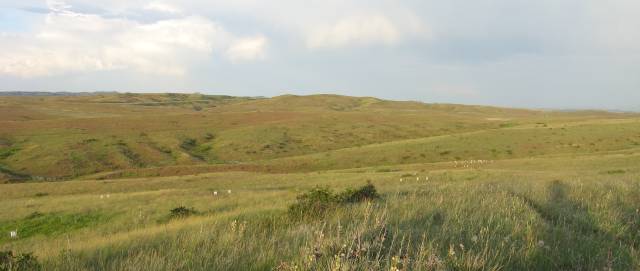
Here's a closeup of one clump. It's really incredible that we have this much detail about a battlefield, and it's what makes Little Big Horn unique in the world. You can see that 5 men fell grouped together, and about 50 yards further, 2 more died. In back of the 5 is a single marker - maybe that man tried to make a break for it before getting cut down, or maybe he was slower than the others.

There was a marker for an Indian here too: Noisy Walking.

'Geez,' Gus said, 'I wouldn't want a guy with that name fighting withmein a battle. 'Hey, uh, Noisy Walking - why don't you and Shoots Wildly go with Can't Follow Directions over that hill and, uh, see if you can surprise the soldiers there. Yeah, thanks. Good luck! ... Whew! Thank the Spiritsthey'regone!'
And then we were back at Last Stand Hill, but now it was nearing 9 o'clock and the shadows were lengthening. A melancholy time for another look at the spot where so many died, and where Custer's body was found.


Finally, several hundred yards - maybe a quarter mile - directly below Last Stand Hill is the Deep Ravine. This is where the last men died in a desperate attempt to break out of the Indians who surrounded them and escape. They never had a chance, and were cut down mercilessly. Remember, every white stone is a spot where a man died.

We drove out of Little Big Horn, and it really was one of the highlights, if not THE highlight, of the trip. If you can, go!
Our motel was in Hardin, MT, about 15 minutes away. We arrived, and Gus checked in. He asked the clerk where to eat, and that guy said 'Shawna's', so to Shawna's we went. This is what it looked like (this was taken the next morning).

We walked in. It was a little dumpy place, with a big bar, several gaming machines, and a few tables. Three or four locals sat around the bar jawboning, eating peanuts, and drinking beer. We asked if we could sit outside, and we ended up at the little table on the left in this picture.

We got our menus, and I immediately thought, uh-oh. The name on the menus was Shawna's Steakhouse, and under that it said, 'We only serve steaks!' Aw, crap. The waitress came over. 'Excuse me, I'm a vegetarian. Do you have anything that's not meat?'
'Well, sure,' she said with a chipper manner, 'The chef will whip ya up some chicken salad!'
'Ummm ...' I paused. I wanted to say, 'Oh yeah! The chicken vegetable! How silly of me to forget that chickens are not meat, but are actually vegetables, meaning that I, a vegetarian, can eat them!' But I didn't. Instead, I said, 'Well, chicken is meat too.'
At that point, Gus interjected, 'They have shrimp. He can eat that.'
True. I will eat seafood if there's nothing else. And there was nothing else. 'I'll take the 4 Jumbo Shrimp.' Gus had a ... surprise! Steak!
The food came out and we ate. Mine was just OK. Then we got the bill. Gus' steak was $12, and my FOUR jumbo shrimp were ... wait for it ... wait ... SIXTEEN DOLLARS! For 4 - count 'em, 4! - shrimp. $4 each!
'What the hell?!' I said to Gus after the waitress left. '$16 for 4 shrimp! What a ripoff!'
Gus looked at me like I was the dunce in a class of slow learners. 'Where are we?' He pauses for me to figure this out, and then continues. 'In Montana! And what's there a lot of around here? Steak! And what's therenota lot of around here? The ocean! And therefore, shrimp!'
The light bulb appeared above my head. 'Ohhhhhh.'
After that, we left Shawna's and headed back to our room. I finished working on a book, but couldn't use the Internet because it was busted. Bad wireless or something. Grrrr. There was always the next morning. Out went the lights. Good night!
